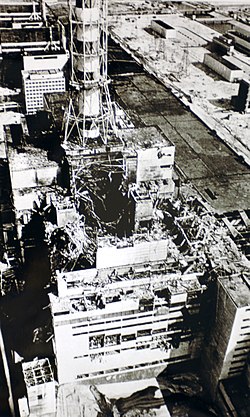1986 ⟶ Chernobyl Disaster
Chernobyl disaster: a Soviet nuclear power plant in Ukraine ...Year
1949
1985
1986
1987
☢️ USSR Tests First Atomic Bomb
The Soviet Union tests its first atomic bomb. The test, known to Americans as [21]" target="_blank" rel="noopener noreferrer" class="text-blue-600 hover:underline dark:text-gray-300 dark:underline dark:hover:text-gray-100">Joe [21], succeeds, as the Soviet Union becomes the world's second nuclear power.⟶

Nuclear weaponsAtomic bombUSSRArms raceCold WarJoe 1Nuclear proliferation
👤 Gorbachev Becomes Soviet Leader
Mikhail Gorbachev becomes leader of the Soviet Union.⟶

Soviet UnionGorbachevLeadershipCold WarPerestroikaGlasnostReformPoliticsUSSR
☢️ Chernobyl Disaster
Chernobyl disaster: a Soviet nuclear power plant in Ukraine explodes, resulting in the worst nuclear power plant accident in history.⟶

ChernobylNuclear AccidentUkraineUSSRDisasterEnvironmental ImpactCold WarNuclear Power
🇷🇺 Gorbachev Announces Perestroika
Natives within the Party who oppose his policies of economic redevelopment (Perestroika). It is Gorbachev's hope that through initiatives of openness, debate and participation, that the Soviet people will support Perestroika.⟶

USSRGorbachevPerestroikaReformPoliticsEconomicsSoviet UnionCold War
🇦🇫 Najibullah Becomes President of Afghanistan
Mohammad Najibullah becomes President of Afghanistan and implements a policy of National Reconciliation as a means of putting an end to the Soviet–Afghan War as well as beginning an end to Soviet influence in the country.⟶

AfghanistanSoviet-Afghan WarUSSRCold WarPoliticsNational ReconciliationNajibullah
🤝 INF Treaty Signed
The Intermediate-Range Nuclear Forces Treaty is signed in Washington, D.C. by U.S. President Ronald Reagan and Soviet leader Mikhail Gorbachev. Some later claim this was the unofficial beginning of the end of the Cold War. Gorbachev agrees to START I treaty.⟶

INF TreatyNuclear WeaponsCold WarArms ControlUSUSSRGorbachevReaganTreaty